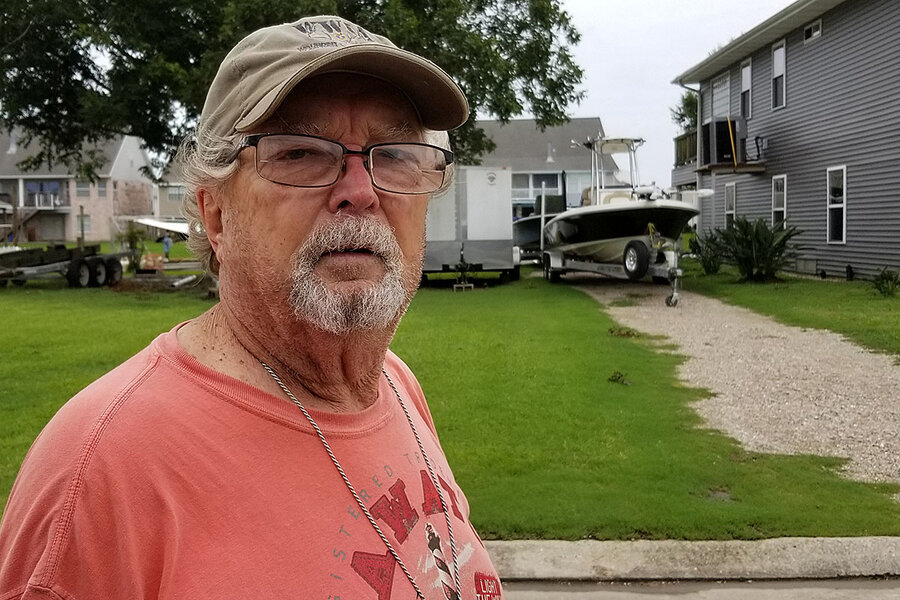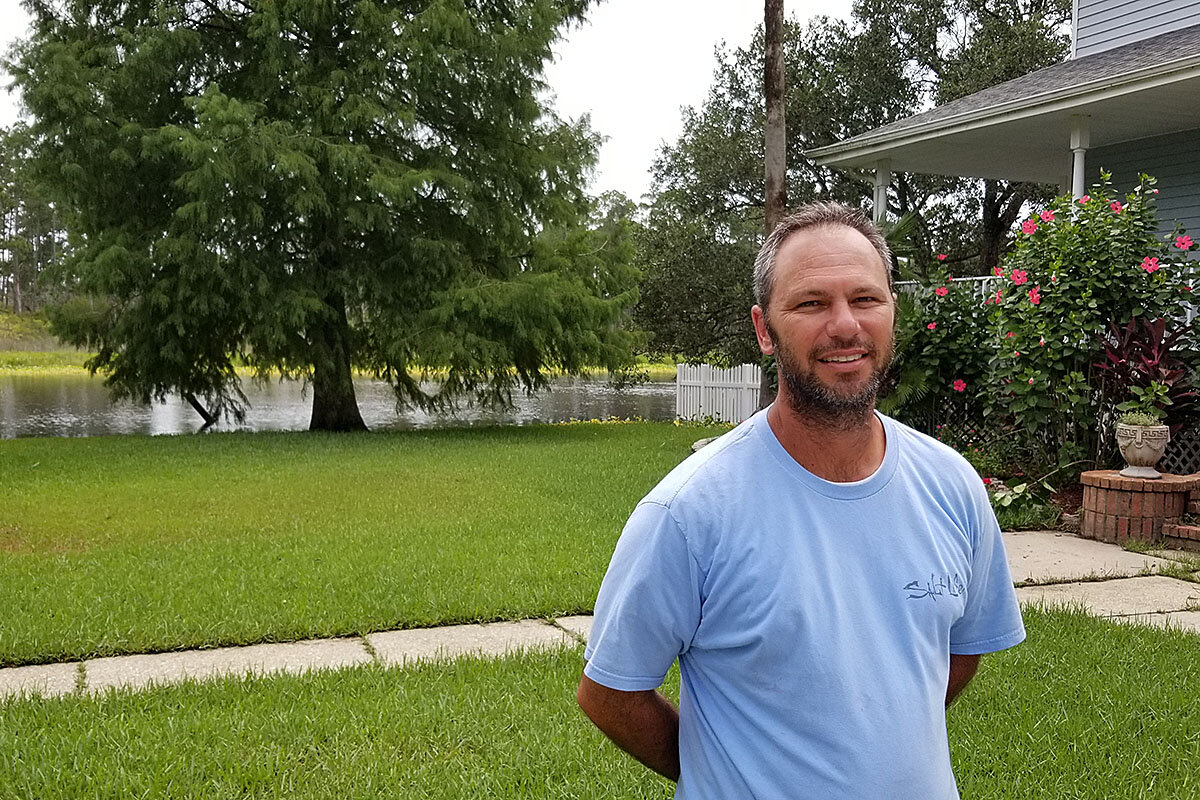Louisiana’s coastline is disappearing. Can the bayou be saved?
Loading...
| NEW ORLEANS
When Don Beaulieu strolls in his middle-class neighborhood of Venetian Isles near the Rigolets strait, net-winged shrimp boats lashed to backyard docks line his path rather than suburban trappings like tennis courts.
Many residents here sideline their income with commercial fishing. Facing nature’s combination of beauty and danger outside the levees has been a point of pride.
Yet Mr. Beaulieu, in his 60s, is considering leaving, given the near-constant floodwaters under his house. When he first moved here 30 years ago, his home was safely nestled behind a thriving marsh. Today, the Gulf is literally at his door.
Why We Wrote This
In Louisiana, the loss of thousands of acres of coastline each year is driving residents to build common ground together. This story is part of an occasional Monitor series on “Climate Realities.”
Mr. Beaulieu’s predicament is shared by tens of thousands of Louisianians juggling rising insurance rates, fading property values, and a growing sense, as he says, of “being stuck.”
“It’s a young man’s game” fighting the constant floods, he concludes. “If they gave me enough money to leave, I would.”
The idea of offering residents money to leave their homes for higher ground may seem like a tough sell in a red state. Nevertheless, Louisiana has taken aggressive steps to advance progressive climate-change adaptation strategies. How Louisianians balance concerns about government overreach with the needs of residents at risk of losing their livelihoods to the sea could hold lessons that carry far beyond the bayous as other coastal states grapple with how to adapt to nature’s challenges.
“It’s like the ‘Three Little Pigs’: You either build a brick house or you kill the wolf – or move away, I guess,” says Robert Twilley, executive director of the Louisiana Sea Grant College Program. “I don’t know how we can kill the wolf, so we’ve got to build a brick house. Now, what does that brick house look like? That is the part that is playing out ... right now in front of our eyes.”
Nationally, partisan battles ranging from concerns about the creep of socialism to lack of political consensus on the causes of climate change have made it difficult “to pierce through to what are really common goals and perspectives.”
That sinking feeling
The early arrival of hurricane season with Tropical Storm Barry earlier this month has underscored the sense of urgency in a state where 10,000 acres disappear into the Gulf every year. Leveeing of the Mississippi River protects homes and businesses, but sends land-building sediment shooting off the continental shelf and into the deeps. Subsidence from sinking peat bogs and nearby oil and gas pumping adds to the problem. Massive marsh loss means storms “come in hard and leave hard,” as Mr. Beaulieu says.
“There’s a lot of moving parts, but for starters, all of southeastern Louisiana is sinking,” says state climatologist Barry Keim.
Already a big escape has begun. Some deep bayou towns have lost half their populations over the past two decades. Those who have stayed have seen insurance costs more than double. What’s more, the encroachment can sink fortunes in home value.
In southeastern Louisiana, “the value of property is directly tied to the rate at which the Gulf of Mexico is moving towards your house,” says Dr. Twilley.
Just weeks before Barry hit, Louisiana released a series of comprehensive strategies for six coastal parishes facing high risk of inundation. Funded by an Obama administration grant and put into motion by Democratic Gov. John Bel Edwards, the so-called Louisiana’s Strategic Adaptations for Future Environments or LA SAFE report outlines the threat and proffers a way forward: a managed retreat that would facilitate relocation through buyouts of constantly flooded homes and funding for “receiver communities” to handle a flood of newcomers. The report also calls for tougher regulations on business and exploration of “floating services” that could service semipermanent settlements on the water.
Now, Governor Edwards has to sell the plan to Republican legislators, many of whom have ties to oil and gas interests. The debate can easily get snagged in the push and pull between competing perceptions of government and individual responsibility. What’s more, the role of climate change is so hotly debated that it often shuts down discussions.
“To go in and do buyouts and mandate regional planning efforts, that all costs lots of money and requires lots of state intrusion into local affairs and people’s private property, which makes it extraordinarily difficult, even for people who know that their property is threatened and have a serious problem,” says Pearson Cross, a political scientist at the University of Louisiana at Lafayette. “They will have to say, ‘Okay, we’re not going to ask you to believe in climate change, but since your houses are going to be flooded again, we need to do something.’”
That sense of urgency is deepening and the state is already shifting its engineering and coastal management philosophy, says Matthew Hiatt, an oceanographer at the College of the Coast & Environment at Louisiana State University, in Baton Rouge. Parishes are reseeding lost mangrove forests to stem land loss. Coastal barrier islands are being bolstered. And plans to loosen the constraints on the Mississippi River to allow natural sedimentation to build land are increasingly on the table.
And the state is already addressing the human dimension of that challenge. Isle de Jean Charles is being left to the elements, and several dozen residents relocated to a new development under a pioneering resettlement approach.
The land, it turns out, remains the common ground.
“We are water people”
Louisiana is tied with Massachusetts for the percentage of people – 90% – who remain near their birthplace for their whole life.
Flood risk has begun to overcome that love of place, underscoring the existential struggle at play.
Yes, houses had water to the rooflines during Hurricane Katrina in 2005, but “no one ever thought St. Bernard Parish would succumb to something like this,” says Mr. Keim, a native of the parish. “I thought most people would come back and to my shock many did not. And the reason was simple: Why sink your nest egg into something that could potentially flood again? But it should also be noted that most of those people didn’t go very far. A lot of them left Chalmette and ended up in Mandeville, still immersed in that south Louisiana culture.”
That shift is embodied by Romy Berel, an oil worker whose middle-class home in Slidell sits right on the bayou. It used to flood once a year. Now it’s four times a year. Even though it never became a mega-destructive storm, Tropical Storm Barry put his entire neighborhood under water. For now, he is bolstering his defenses by raising his house, as is his neighbor. In 2006, he sold a smaller house that got flooded in Katrina and bought this one – bigger, higher in the air, but closer to the bayou.
Politically, he has no problem with taxpayer buyouts to allow nature to reclaim the land. He notes that the closing of a key canal to the Gulf to protect New Orleans seems to have intensified the flooding of his property. If government helps precipitate a crisis, he says, then it could, out of plain fairness, help people adjust.
But there is a catch, he chuckles.
“Sure, I would take a buyout if it gets worse,” he says. “But we are water people, always have been, always will be. I’d just go back on the water somewhere else.”
This story was produced with support from an Energy Foundation grant to cover the environment.







